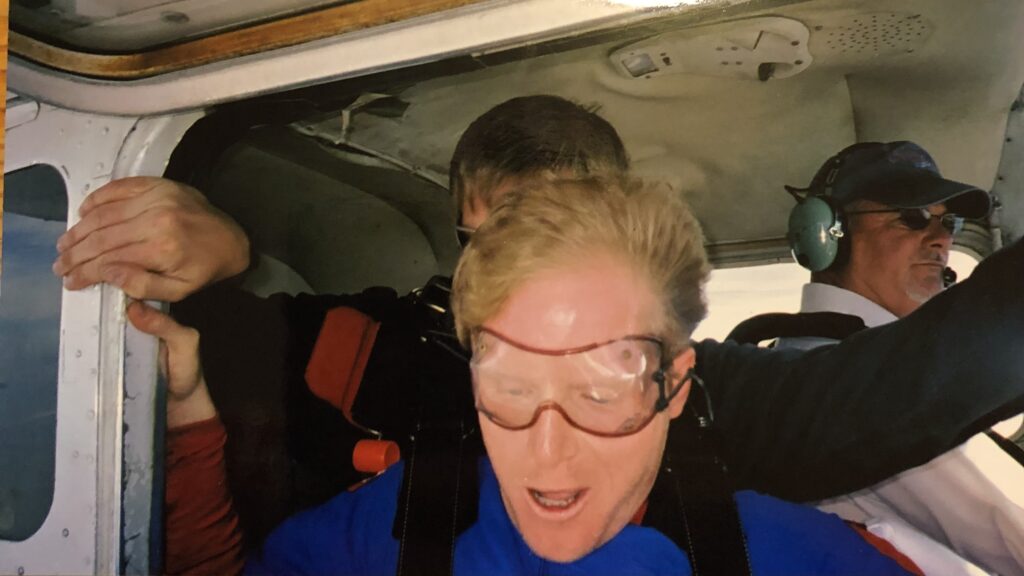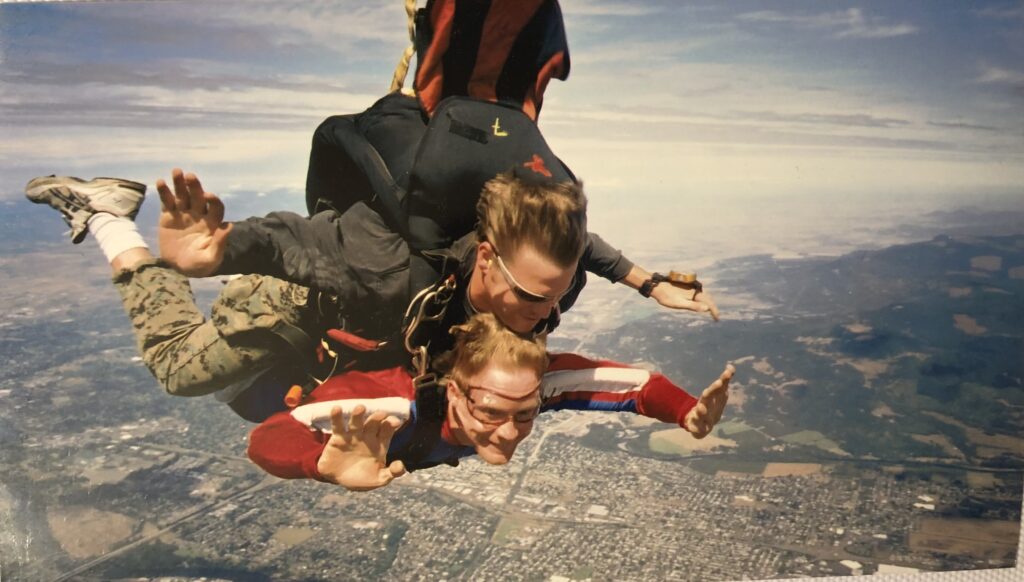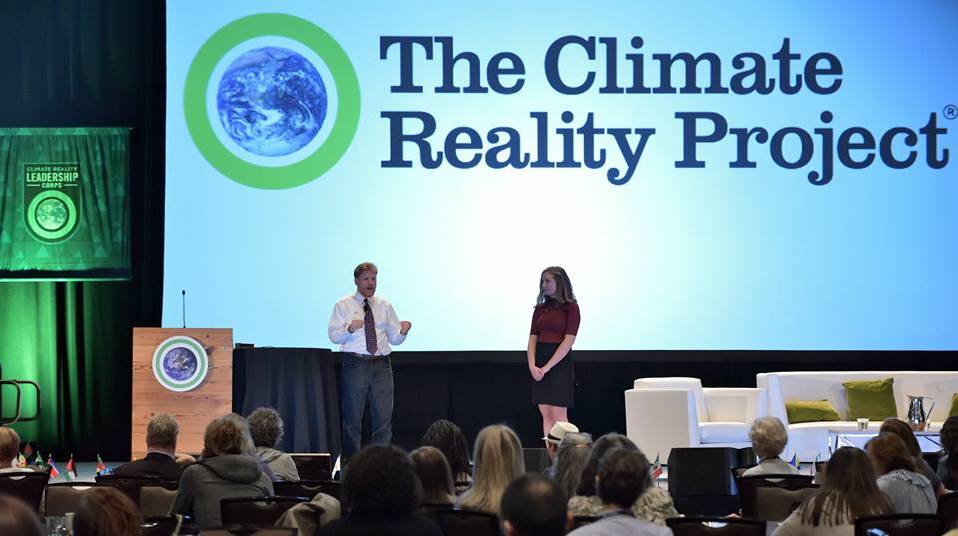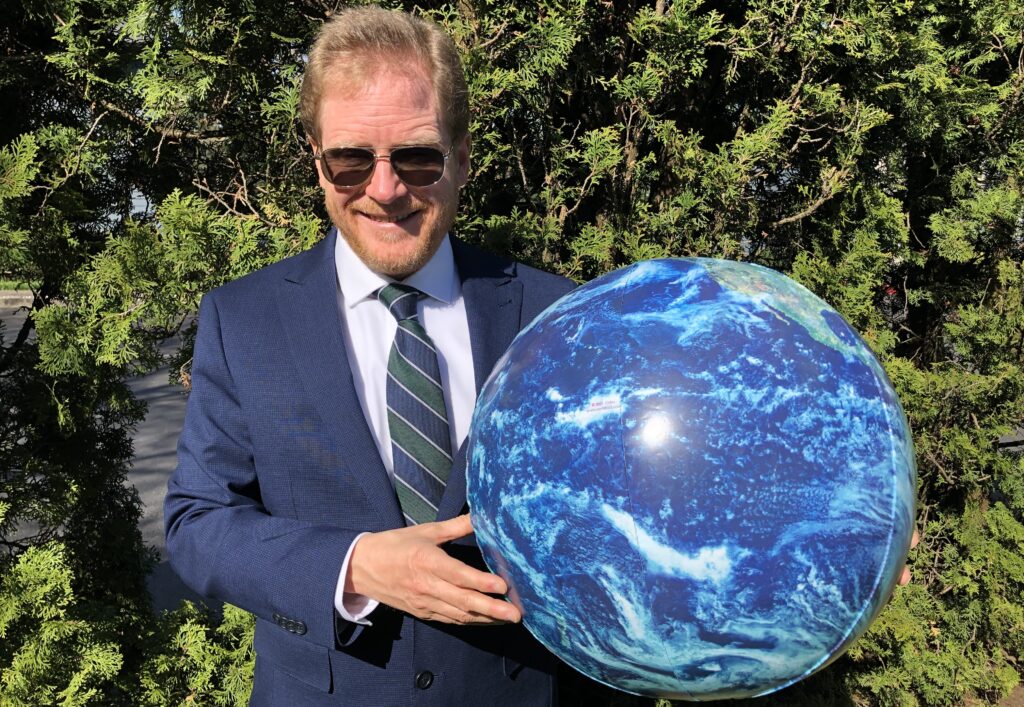
In 2006, I accepted a summer job as an interpretative ranger at Crater Lake National Park. After many years of working other jobs at Crater Lake, I felt triumphant leading a lodge talk about the park founder William Gladstone Steel, giving a geology talk, and narrating the boat tours that summer. In late August, I debuted a junior ranger program and an evening campfire program when other rangers left for the season to return to their teaching jobs.
This summer job was in addition to my winter job in Everglades National Park, Florida where I worked as an interpretative park ranger narrating the boat tours, led guided canoe trips into the Ten Thousand Islands, provided ranger guided bike tours of Everglades City, and gave evening programs on the birds of Everglades National Park. I was really enjoying my work as a ranger at this time, but I wanted to challenge myself in a new way at this time.
Skydiving in south Florida in April 2007 for the first time
In 2007, I decided to stretch my boundaries by going tandem skydiving twice. The first time was in south Florida in April 2007, at a small airport near Everglades National Park. This was a life goal I have been itching to do for a few years. The Everglades is extremely flat with no hills or mountains. This would be my opportunity to finally get a bird’s eye view of south Florida.
My friend and fellow Everglades ranger, Jackie Dostourian, joined me for moral support that day. She decided that day that she was not going to skydive, and I was fine with that. I was determined to do it. It was great having her at the facility as I was very nervous before this experience, and she immediately saw me after I completed my jump.
I would be completing a tandem skydive, attached to a professional who does this for a living. After I paid the hefty fee, the other customers and I were shown a 20-minute video to prepare for our tandem sky dive. The narrator on the video explained how he designed the tandem skydiving equipment for maximum safety. Oddly, he had a very long hair and beard, and piercing eyes that spoke right into the camera and right into you. He was wearing a suit and tie. His hair and beard were so long that they covered up his shirt and suit collars and his tie knot. The narrator looked like a cult leader, not a businessman selling people on skydiving. I was very nervous to complete this life goal. My mind was committed, but my body thought it was a terrible idea to want to jump out of a perfectly good airplane. Thus, I was scared this narrator was going to say towards the end of this video, ‘And if you find that you enjoyed your skydive, I hope you will join us to live in our community forever.’
My body was waiting for a message like this on this video so we could go screaming out of there. After watching the video with the others committing themselves to skydiving that day, I met the person I would be attached to for this tandem skydive. He was a friendly guy in a profession where everyone needs to be super chill to relax nervous folks like me. Yet, he was confident and very detail oriented to also help relax and calm down nervous folks like me.
For me, getting ready to go skydiving felt the same feeling as going to the dentist. My mind was totally set to do this, but my body wanted no part of it!

The weather was a typical Florida partly cloudy day. There were enough clouds rolling in that the professional skydivers had to wait until the last minute to decide if it was safe to jump out of the plane. They made this decision after the plane took off and we were 10,000 feet above the ground. The person making the decision was the lead skydiver, who was attached to me. The door was open on the side of the plane to make the decision. Each time he leaned of the plane to make the final call, I was leaning out of the plane with him. It was freaky looking out 10,000 feet below me with nothing between me and the ground. It’s not natural to be looking down on clouds thousands of feet below me. This was one scariest parts was when he leaned over the side several times before he made his final call.
To the joy of my mind and the horror of my body, he determined it was safe for all of us to jump out of the airplane. Before we knew it, I was outside of a perfectly good airplane falling 110 miles per hour. It sounded so damn loud. It sounded like if you choose to drive your car at 110 mph with the windows down. The Everglades looked huge and flat from high up in the sky, not much different than the ground. We just needed to aim for the landing zone, which was right next to Everglades National Park. I did not want to end up in the Everglades with all the alligators, venomous snakes, etc.
The experience was over in just a few minutes. I was thrilled that I accomplished it. It was great that Jackie was there to greet me when it was over to share this experience with her. I called up my parents and sisters that evening to let them know I skydived that day. None of them seemed impressed. My dad remarked, “Don’t ever do that again!”
I always had a rebellious streak in me. After my dad said that I was determined to do it again. I decided to do it again in Oregon when I returned to work at Crater Lake for the summer. I found co-workers at Crater Lake who were interested in joining me. We made our reservation to skydive in early August.
My second skydive in Oregon while losing my mentor Steve Robinson
For this second time, I wanted to skydive to see the mountains of Oregon from 10,000 feet. This time, I decided to pay extra to have a video made of this skydive and pictures taken to remember this experience. My skydiving video is posted on YouTube.
My friends and I skydived in Creswell, Oregon, just south of Eugene. It was odd to be looking down directly on Interstate 5 as I skydived, which looked like a small ribbon of a highway. The cars and full-sized trucks looked like tiny ants as they moved down the highway in either direction. The landing zone was right next to a field of corn. My friends and I enjoyed purchasing some corn from that field immediately after our skydive.
In 2007, along with the skydiving experience, I had a terrific summer as an interpretative ranger at Crater Lake. Yes, this was a peak life experience to go skydiving twice in 2007. I reached a life goal and felt like I was on top of the world.
Sadly, the thrill of this occasion ended when tragedy struck within days of my second skydive. I received the news that my mentor, friend, and fellow park ranger at Crater Lake and Everglades National Park, Steve Robinson, was diagnosed with pancreatic cancer. Steve lived his life to the fullest and enjoyed every day of his life. He inspired me to life my life the same way. Days later, when I visited Steve in the hospital, he was completely emersed in his battle with this deadly and aggressive cancer. My sky dive seemed so frivolous compared to his fight with cancer.
It felt like that skydive was the last fun thing I did before Steve passed away on October 1, 2007. For the next year, I was in a fog mourning the death of my friend. To help me recover, friends who were also close to Steve invited me to visit them on the Big Island of Hawaii in October 2008. During my visit, my friends shared that Native Hawaiians consider the Big Island as a place of healing. With their words and spending time in this tropical paradise, I found permission to enjoy life again. I achieved new life goals of surfing, parasailing, snorkeling, and seeing native Hawaiian birds, Even more, with this trip, I reached my goal of seeing all 50 U.S. states.
My body and probably Steve were relieved that I moved onto new adventures to enjoy life, besides jumping out of perfectly good airplanes.

Skydiving twice and the loss of my mentor pushed me to be a climate organizer
My mentor Steve worked as a seasonal park ranger in Everglades National Park and Crater Lake National Park for 25 years. I never met anyone who loved the outdoors and the natural environment as much as Steve. With his salt and pepper long hair tied back into a single Indian braid and his long his bushy grayish beard that flowed down to almost his shirt collar, Steve looked like a cross between Moses from the Bible and Dr. Suess’ The Lorax.
Steve cared deeply about protecting the Everglades and restoring this precious ecosystem to its full glory. Park visitors, his fellow rangers and me would hang onto every word he said. I wanted to be like Steve and spend the rest of my life working the national parks educating park visitor to care for the Everglades and our planet. I wanted to tell entertaining and inspiring stories like Steve did to inspire visitors to be good stewards of the Everglades and our planet.
In his ranger talks and his conversations, Steve liked to use a quote that was originated with Joe Podger but he attributed it to his iconic hero and mother of Everglades National Park, Marjory Stoneman Douglas. The quote was,
“The Everglades is a test. If we pass the test, we get to keep the planet.”
When I arrived in Shark Valley in Everglades National Park in November 2007, I could not sleep at night, and I fell into a very bad depression. My Supervisor in Everglades City from 2004 to 2007, Sue Reece, offered me a new challenge to work in Shark Valley for the winter. However, after I arrived in Shark Valley, I felt very isolated and lonely. I missed my friends in Everglades City. I wanted to leave the Everglades, but I did not know where I wanted to go.
In my sleeplessness, depression, and restlessness, I found my life’s purpose. I wanted to carry forth my mentor Steve’s message of protecting our Earth and environment since he could no longer share that vision with others.
I recalled 1998 when I started giving ranger talks in Everglades National Park. Visitors then asked me about this global warming thing. Visitors hate when park rangers tell you, “I don’t know.” Visitors expect park rangers to know everything. Don’t you?
Soon afterwards, I rushed to the nearest Miami bookstore and to the park library to read all I the scientific books I could find on climate change.
The information I learned really scared me, specifically sea level rise along our mangrove coastline in Everglades National Park. Sea level rose 8 inches in the 20th century, four times more than it had risen in previous centuries for the past three thousand years. Because of climate change, sea level is now expected to rise at least three feet in Everglades National Park by the end of the 21st century. The sea would swallow up most of the park and nearby Miami since the highest point of the park road is three feet above sea level.

By the winter of 2007-08, I read several books on climate change. Al Gore’s film, An Inconvenient Truth and his companion book, as well as the HBO documentary Too Hot Not to Handle, dominated my thoughts. I wanted to do something on climate change, but I did not know what. It very clear I would not find the answer by continuing to work winters in the Everglades. It was time for me to move on with my life. By the winter of 2007-08, I was burned out of the south Florida climate, the very flat terrain, and the long cross-country drive to spend the winter in the Everglades. Even worse, as a single man, it seemed like I would not find a wife there.
I said goodbye to the Everglades at the end of April 2008. I decided I would spend my winters in my hometown of St. Louis Missouri to organize for climate action. I had no idea how I was going to do that, but I was excited I found my life’s purpose.
I was comfortable spending my winters in the Everglades. Thus, it was scary for me to step outside of this comfort zone to try something different, especially climate change organizing. The mantra I kept telling myself was: “If I could skydive twice to overcome the daunting fear of jumping out of a perfectly good airplane, then I could achieve anything that I gave full intention.”
My skydiving adventure led me to achievements in climate action
In November 2009, I argued with my friend Naomi in Ashland, Oregon about what I should with my life with this climate change life mission. She kept pushing me harder. Finally, I snapped, “Fine! If I could do anything, I would like to be ‘The Climate Change Comedian!”
Naomi was a tough audience, but she nearly fell out of her fell out of her chair laughing. She responded: ‘That’s perfect! I want you to go home and grab that website domain name now, www.climatechangecomedian.com.’
In December 2009, I returned to my hometown of St. Louis, Missouri to spend the winter. During that winter, Naomi advised me to fully develop my website and create my own climate change PowerPoint that I would use for my presentations. Early in 2010, I developed my first climate change PowerPoint, “Let’s Have Fun Getting Serious about Climate Change.” I showed that PowerPoint to friends and family in the St. Louis. A family friend helped me launch my climatechangecomedian.com website that is still active to this day.
In the back of my mind when I took these leaps to take on the title of “The Climate Change Comedian,” create my own website, and develop my own PowerPoint to show family and friends, I kept saying to myself, “Because I had the courage to skydive twice, I can do this new action!”
As I climate change organizer and wannabe comedian, I kept taking new actions outside of my comfort zone. I joined South County Toastmasters in January 2011 because I decided that becoming a Toastmaster would enable me to be a better climate change communicator. In March 2011, I applied and was offered a job at the St. Louis Science Center at their temporary Climate Change exhibit. I wanted this job to immerse myself in this exhibit to learn about climate change and chat about climate change with the museum visitors daily.

While working at this exhibit, I met a local businessman Larry Lazar. We decided to co-found the St. Louis Climate Reality Meet Up in December 2011 (now known as Climate Meetup-St. Louis).
This Meet Up group is where I met Tanya Couture. She attended our events beginning in January 2012. We started dating in February 2013. We got married on November 1, 2015. As I joke in my climate talks, ‘Join the climate movement, you might meet the person of your dreams!’
In August 2011, I gave my first climate change ranger evening program at Crater Lake National Park, called The Good, The Bad, and The Ugly. I performed this ranger talk at Crater Lake for the next five summers, up until 2017. Over the past 13 years, I ended up giving over 200 climate change talks in 12 U.S. states, Washington D.C, and Ottawa, Canada.
One of those speeches was at the Shrine of the Ages Auditorium at Grand Canyon National Park to an audience of over 200 park visitors and park staff in May 2013. Due to my ranger connections of working in the national parks for 25 years, my friend Pete invited me to give this talk.
Because of the courage I gained sky diving twice and wanting to emulate my mentor Steve Robinson, I pursued every opportunity to get out the message about taking climate action. This included writing a blog since 2011, writing opinion editorials in the St. Louis Post-Dispatch and the Oregonian starting in 2013, doing local radio interviews, and in 2014, making funny short videos with my wife (then girlfriend) Tanya, my mom Fran Ettling, and my dad LeRoy Ettling.
These short YouTube videos that I did with my parents and Tanya caught the attention of Comedy Central’s Tosh.o TV show. A year later, a producer of the show called me to invite my Mom and I to fly to Los Angeles to do a comedy segment with the show’s host, Daniel Tosh. Our comedy segment first aired Comedy Central on August 2, 2016. It’s called “The Climate Change Comedian – Web Redemption.”
My audacity I obtained from skydiving twice sparked me to travel to Washington D.C. 9 times from 2015 to 2023 to attend Citizens’ Climate Lobby (CCL) conferences and lobby days. I lobbied numerous Congressional Offices, and briefly chatted with U.S. Senator Claire McCaskill from Missouri. While participating the June 2019 CCL Lobby Day on Capitol Hill in Washington D.C, I helped lead the efforts to persuade Florida Congresswoman Frederica Wilson to sign on as a co-sponsor on CCL’s Energy Innovation and Carbon Dividend Act.
The thrill of adventure I received from skydiving coupled with my passion to take climate action, led me to attend a Climate Reality Training led by Al Gore in San Francisco, CA in August 2012. At that training, I proudly became a Climate Reality Leader. Since then, the Climate Reality Project invited me to be a mentor for 8 Climate Reality Trainings from 2013 to 2020. At four of those trainings, Climate Reality selected me to be a breakout speaker on how to give Climate Reality Presentations and how to find an audience to give climate change talks.

The fearlessness I got from skydiving in 2007 motivated me to lead 3 CCL state speaking tours:
1. Missouri: March 27-31, 2017.
2. Oregon: October 24-November 4, 2017.
3. Missouri: October 8-17, 2018
The confidence I absorbed from skydiving in 2007 and wanting to follow my mentor Steve Robinson’s example of speaking out to protect our planet led me to be a breakout speaker for 4 national CCL conferences in 2017, 2019, 2020, and 2021.
As a breakout speaker for the national conferences, I spoke on topics such as Protecting and Conserving Endangered Species in the Face of Climate Change, Mastering Town Halls, Engaging Colleges on Climate Change, and Securing Local Elected Officials’ Endorsements.
The boldness I recalled jumping out of a perfectly good airplane on a tandem skydive in 2007 influenced me in 2021 to be the lead organizer for the efforts of Oregon CCL to convince the Oregon Senate to pass a state resolution known as Senate Joint Resolution 5 or SJM 5. This Oregon resolution urged Congress to pass the Energy Innovation and Carbon Dividend Act. SJM 5 passed the Oregon Senate on April 7, 2021 by a vote of 23 to 5, with 6 Republican Senators voting in favor of it. SJM 5 fell short of getting passed in the Oregon House. However, it did attract 30 House co-sponsors, which is half of the chamber, and included 7 Republican co-sponsors.
The effort for SJM 5 grew out of my 2020 efforts to successfully persuade 30 Oregon legislators, including the then House Speaker and now current Governor, to endorse the EICDA.
I could go on to talk about the sense of accomplishment I felt from skydiving in 2007 and wanting to share about my love for the earth like my mentor Steve Robinson impacted me to
– Write numerous published letters to the editor about CCL published over the years, including my most recent one in the Oregonian on December 1, 2023.
– Give oral testimony 9 times to Oregon Legislative committees since 2019 to urge Oregon Legislators to support climate legislation.
Final Thoughts
Could I have achieved all this without skydiving? Maybe. Possibility. Nearly everyone I met in the climate movement probably has not gone skydiving. They have taken very effective actions without ever jumping out of a perfectly good airplane and then having faith that a parachute and a tandem skydive professional would guide them safely to the ground. I just know for me that skydiving twice gave me a big boost in self-esteem to go more boldly into the world.
I hope if you read to the end of this blog that you don’t feel like you must skydive to live your best life or to make a difference to act on climate. However, I still hope I can inspire you to find a way to find your own adventure and path to live your life to the fullest and to try to make a difference while you are alive, especially to reduce the threat of climate change.
While he was alive, my mentor Steve Robinson treated everyday as a gift, and he strived to live his life to the fullest. He was fully present in every interaction in nature and conversation with another person. He taught me so much about making the most of each day and life experience.
Writer, professor Joseph Campbell, who was an expert in comparative mythology and comparative religion, had this to say from his 1987 interview and book, Joseph Campbell and Power of Myth with Bill Moyers.
“People say that what we’re all seeking is a meaning for life. I don’t think that’s what we’re really seeking. I think that what we’re seeking is an experience of being alive.”
Whether or not you skydive or find that ultimate experience of being alive, my wish is that it will somehow lead you to want to take greater care of our environment and planet.

